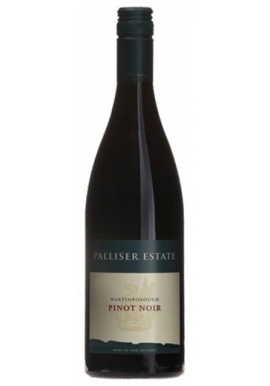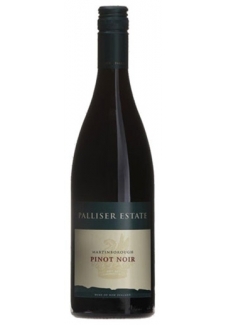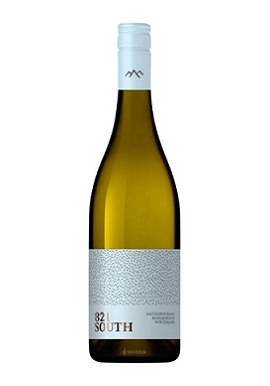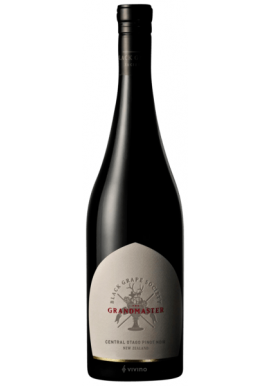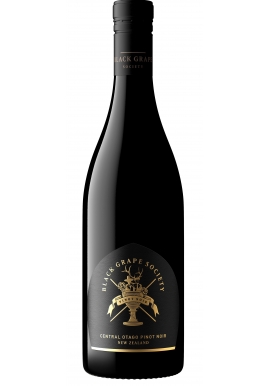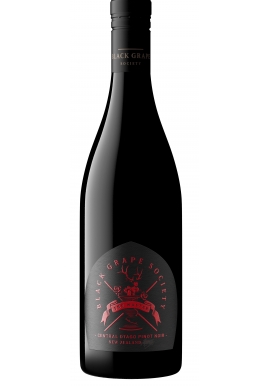New Zealand
New Zealand wine is produced in several winegrowing regions of New Zealand. The country's elongated island geography in the South Pacific Ocean results in maritime climates with considerable regional variation from north to south. Like many other New World wines, it is usually produced and labelled as single varietal wines, or if blended the var...
New Zealand wine is produced in several winegrowing regions of New Zealand. The country's elongated island geography in the South Pacific Ocean results in maritime climates with considerable regional variation from north to south. Like many other New World wines, it is usually produced and labelled as single varietal wines, or if blended the varietal components are listed on the label. New Zealand is best known for its Marlborough Sauvignon Blanc, and more recently its dense, concentrated Pinot Noir from Marlborough, Martinborough and Central Otago.
While New Zealand wine traces its history to the 19th century, the modern wine industry in New Zealand began in the mid-20th century and expanded rapidly in the early 21st century, averaging 17% per annum in the first two decades. In 2019, New Zealand produced 297 million litres from 38,680 hectares (95,600 acres) of vineyard area, about three-quarters of which is dedicated to Sauvignon Blanc. Nearly 90% of total production is exported, chiefly to the United States, Britain and Australia, reaching a record NZ$1.83 billion in export revenue in 2019. In each of the previous 10 years, New Zealanders consumed a fairly constant 20 litres of wine per adult, about a third of which was imported from other countries, mainly Australia.
White Wines
Cloudy Bay brought New Zealand's Marlborough Sauvignon Blanc to international attention in the 1980s; Chardonnays from Martinborough (Wairarapa) and Kumeu (Auckland) regions; a single vineyard Viognier from Gisborne; Riesling and Pinot Gris from Central Otago.
Sauvignon Blanc
New Zealand has long been best known for its Sauvignon Blanc, which dominates New Zealand's wine industry. In 2017 its vines took up 22,085 hectares (54,570 acres) of vineyard area, a full 60% of New Zealand's total grape planting, and Sauvignon Blanc wine made up 86% of the nation's exports. New Zealand's Sauvignon Blanc is regarded by many critics as among the best in the world.[14] Historically, Sauvignon Blanc has been used in many French regions in both AOC and Vin de pays wine, and famously Sancerre and Pouilly Fumé. Following Robert Mondavi's lead in renaming Californian Sauvignon Blanc Fumé Blanc (partially in reference to Pouilly Fumé, but also to denote the smokiness of the wine produced from flinty soil and oak barrel ageing), there was a trend for oaked Sauvignon Blanc in New Zealand during the late 1980s. Strong oaky overtones dropped out of fashion through the 1990s but have since made a come-back, with several makers now offering oak-aged Sauvignon Blanc (Greywacke, Dog Point, te Pa Sauvignon Blanc 'Oke', Sacred Hill “Sauvage”, Jackson Estate "Grey Ghost", and Saint Clair “Barrique”).
Chardonnay
Chardonnay is produced as far south as Central Otago, but plantings increase the further north one goes. There is little discernible difference in styles of Chardonnay between the New Zealand wine regions; individual winemakers' recipes, use of oak, and the particular qualities of a vintage have tended to blur any distinction of terroir. It is therefore unsurprising that almost every region is represented among the most highly rated New Zealand Chardonnays, which include wines from Kumeu River Estate (Kumeu), Church Road, Clearview, Sacred Hill, Villa Maria and Te Mata Estate (Hawke's Bay), Ata Rangi (Martinborough), Fromm (Marlborough), Neudorf (Nelson), Millton Estate (Gisborne). Although Chardonnay may be less fashionable than it was ten years ago (it has declined in vineyard area in the last ten years, losing ground to Pinot Gris), winemakers in 2016 reported strong sales and a recent upswing. It also commands higher prices than any other New Zealand white wine variety.
Pinot Gris
Pinot Gris emerged in the early 2000s from almost nowhere to the country's fourth most planted variety 2017, overtaking Riesling in 2007. It is planted mostly in Marlborough, Hawke's Bay and Gisborne, with the remainder in the South Island. Some of the initial plantings of Pinot Gris were identified later as Flora; indeed, some Auckland winemakers have incorporated this mishap into their Flora wine names, such as "The Rogue" from Ascension and "The Impostor" from Omaha Bay Vineyards.
Other White Wines
Other white wine varietals grown in New Zealand include (in descending order of vineyard area) Riesling, Gewürztraminer and Viognier, and less commonly Chenin Blanc, Albariño, Arneis and Sémillon. Riesling is produced predominantly in Martinborough and the South Island. The same may be said about Gewürztraminer, although it is also planted extensively in Gisborne.[17] Chenin Blanc was once more important, but the viticultural peculiarities of the variety, particularly its unpredictable cropping in New Zealand, have led to its disfavor. Good examples nevertheless exist, from Esk Valley, Margrain and Millton Estate.
Red Wines
Today, New Zealand is internationally most well known for red wines made from traditional French varieties. After Sauvignon Blanc, Pinot Noir has become New Zealand's second most planted variety, while in the warmer regions, particularly Hawke's Bay and Waiheke Island, Syrah and Bordeaux-style blends of mainly Merlot and Cabernet Sauvignon have been gaining recognition.
Pinot Noir
Several Pinot Noir Wines from Central Otago.
The late 1970s was early in the modern wine industry, and the comparatively low annual sunshine hours to be found in New Zealand discouraged the planting of red varieties. Despite this, some held great hopes for Pinot Noir. Initial results were mixed due to limited access to good clones, yet the Saint Helena 1984 Pinot Noir was notable enough that the Canterbury region was thought to become the New Zealand home for Pinot Noir. While the early excitement passed, the Canterbury region has witnessed the development of Pinot Noir as the dominant red variety, particularly in the now dominant Waipara sub-region. Producers include Waipara Hills, Pegasus Bay, Waipara Springs, Muddy Water, Greystone, Omihi Hills and Black Estate.
The next region to excel with Pinot Noir was Martinborough, 75 kilometres east of Wellington in the Wairarapa region. Several vineyards, including Palliser Estate, Martinborough Vineyards, Murdoch James Estate (now Luna Estate) and Ata Rangi consistently produced interesting and increasingly complex wine from Pinot Noir at the end of the 1980s and into the 1990s.
At around this time the first plantings of Pinot Noir in Central Otago occurred in the Kawarau Gorge. Central Otago had a long (for New Zealand) history as a producer of quality stone fruit, particularly cherries. Significantly further south than all other wine regions in New Zealand, it nevertheless benefited from being surrounded by mountain ranges which increased both its daily and seasonal temperature variations, making the climate unusual in the typically maritime conditions in New Zealand, and ideal for growing Pinot Noir. Indeed, recent years have seen Pinot Noir from Central Otago winning numerous international awards and accolades, and have excited the interest of British wine commentators including Jancis Robinson and Oz Clarke. Not only did the wines have the distinctive acidity and abundant fruit of New Zealand wines, but they demonstrated a great deal of complexity, with aromas and flavours not common in New Zealand wine and normally associated with burgundian wine. Notable producers include Akarua, Felton Road, Chard Farm and Mount Difficulty.
In a blind tasting of New Zealand Pinot Noir in 2006, Michael Cooper reported that of the top ten wines, five came from Central Otago, four from Marlborough and one from Waipara. This compares with all top ten wines coming from Marlborough in an equivalent blind tasting in the previous year. Cooper suggested that this has to do with more Central Otago production becoming available in commercial quantities, than the relative qualities of the regions' Pinot Noir.
As is the case for other New Zealand wine, New Zealand Pinot Noir is fruit-driven, forward and early maturing in the bottle. It tends to be quite full bodied (for the variety), very approachable and oak maturation tends to be restrained. High quality examples of New Zealand Pinot Noir are distinguished by savoury, earthy flavours with a greater complexity. In an article in Decanter (September 2014), Bob Campbell suggests that regional styles are starting to emerge within New Zealand Pinot Noir. Marlborough, with by far the largest plantings of Pinot, produces wines that are quite aromatic, red fruit in particular red cherry, with a firm tannic structure that provides cellaring potential.
Bordeaux-style blends and Syrah
New Zealand red wines are also made from the classic Bordeaux varieties, mainly Merlot, with Cabernet Sauvignon, Cabernet Franc, Malbec, and Petit Verdot. Syrah wines from Hawke's Bay, particularly the Gimblett Gravels and Bridge Pa Triangle sub-regions, as well as further north from Waiheke Island have also gained a good reputation internationally.
Early success in the Hawke's Bay Region in the 1960s by McWilliams and in the 1980s by Te Mata Estate, led to a phase in the 1980s and 1990s of mainly Cabernet Sauvignon planting and wine production by large producers such as Corbans, McWilliams, and Mission Estate. As viticultural techniques were improved and tailored to New Zealand's maritime climate, other Bordeaux-style grapes were planted, and a switch of emphasis made to the more suitable, earlier-ripening Merlot. Today, Merlot is the second most planted red variety after Pinot Noir, accounting for 1,203 hectares (2,970 acres), far outweighing Cabernet Sauvignon plantings by five to one.
Typically, these Bordeaux blends come from the hotter and drier regions of New Zealand, largely in the Hawke's Bay Region. Wines that typify the best of Hawke's Bay include Elephant Hill "Airavata", Te Mata Estate's “Coleraine”, Craggy Range's “Sophia”, Newton Forrest Estate's “Cornerstone”, Esk Valley's “The Terraces” and Villa Maria's Reserve Merlot and Cabernet. Waiheke Island, whilst a very small viticultural region, also produces acclaimed red wines such as the “Larose” from Stonyridge, and wines from Destiny Bay, Man O' War, and Goldie Estate. In Marlborough there are also a small number of producers of Bordeaux-style varietal wines, and examples of Bordeaux blends can be found as far south as Waipara, where the “Maestro” from Pegasus Bay also demonstrates the shift from Cabernet Sauvignon to Merlot predominant blends.
The amount of Cabernet Sauvignon in production has dropped to a third of what it was in the early 2000s, and has been overtaken by a tripling of Syrah planting in that time. In the same time period, Sauvignon Blanc has grown more than five-fold and Pinot Noir has doubled. Whilst today's fashion has turned from Bordeaux blends to Pinot Noir, it also indicates the marginality of Cabernet Sauvignon in New Zealand conditions.
Other red wines
There are some producers dedicated to establishing other red grape varieties. New Zealand has small plantings of Tempranillo, Pinotage, Montepulciano and Sangiovese in Hawke's Bay and the warmer Auckland regions.
Rosé
Most New Zealand wine producers that produce Pinot Noir or Merlot also produce a rosé style wine, although it is sometimes found made from other red varieties. New Zealand rosé is made to drink immediately rather than age, resulting in the crisp, fresh, fruit-forward flavours popular with the New Zealand public. Well rated examples are from Forrest, Isabel, Ti Point, Whitehaven and Rapaura Springs.
Sparkling Wine
Méthode Marlborough, a collaboration of sparkling wine producers.
Méthode traditionelle sparkling wine is produced in New Zealand. The first made commercially was a wine called Champelle, made in 1956 by Selaks in Kumeu. In 1975 Daniel Le Brun, a Champagne maker, emigrated to New Zealand to begin producing méthode traditionelle in Marlborough. The suitability of the Marlborough terroir and success of the wines produced over the next 20 years were sufficient to attract investment from large Champagne producers, most notably Deutz and Moët & Chandon. Today, the Le Brun family continue to produce well awarded Méthode sparkling wine, operating as No. 1 Family Estate, after the Daniel Le Brun name was acquired by Lion. In 2013 several Marlborough producers established Méthode Marlborough, a collaborative organisation to standardise and promote the brand both domestically and internationally.
Although the majority of méthode traditionelle sparkling wines in New Zealand are made in Marlborough, there are also fine examples from throughout the rest of New Zealand. Quartz Reef is based in Central Otago, Church Road in Hawke's Bay, Lindauer was originally established in Gisborne (and now also owned by Lion), and there are makers as far north as the Auckland regions as well.
Exports of New Zealand sparkling wines are chiefly to the United Kingdom, where the best known examples there are the Pelorus from Cloudy Bay, now part-owned by LVMH Moët Hennessy Louis Vuitton, and the Special Reserve from Lindauer. More recently, exports of méthode have been declining, halving in volume between 2005 and 2011, and now making up less than 1% of total New Zealand exports. This is partly due to a rise in popularity and production of sparkling Sauvignon Blanc, a new style of sparkling New Zealand wine.
Wine regions of New Zealand
Map showing the major New Zealand wine regions (Geographical Indications)
New law came into force in New Zealand in 2017 that established a Geographical Indication (GI) classification for New Zealand wine, equivalent to European Protected Geographical Indication (PGI) classification and the American Viticultural Areas in the United States. In 2017 a total of 18 applications were lodged with the GI register at the Intellectual Property Office of New Zealand, and registrations were complete by early 2019.
Northland
Northland is the most northerly wine region in New Zealand, and thus closest to the equator. A Geographical Indication since October 2017, it is also the smallest GI, producing 92 tonnes in 2016 from an area of only 64 hectares (160 acres) under vines.[6] Although Chardonnay is the most planted variety, it is most well known for ripe Syrah red wines, and white wines from Pinot Gris, which together comprise the top three planted varieties. Some Northland wineries are also making wine from warmer climate grapes such as Montepulciano, Chambourcin and Pinotage. The combination of high summer temperatures and high rainfall can be challenging for viticulture; although irrigation is not needed, the humidity can encourage some pests and diseases. The fertile soils and Northland climate also results in high vine productivity, requiring good vineyard management to limit yields in order to ensure better quality wines. Consequently, Northland tends to produce ripe wines, with low acidity.
New Zealand There are 4 products.
Subcategories
-
Reds
New Zealand red wines have lagged behind for a while, as one might have expected in a generally cool, damp climate. Much of the Cabernet Sauvignon was excessively light and herbaceous, its whiff of raw green pepper skin too often complaining of climatic indignities in the vineyard. With better selection of planting areas, and judicious blending with Merlot, that picture has now improved beyond recognition. Even better has been Pinot Noir, always a likelier bet in a cool climate, with wines that are now challenging the best of California for sheer opulence of fruit, and bright balancing acidity.
Pinot Noir is now the most widely planted red grape, and is flexing its muscles on the world stage with wines of scintillating complexity, diamond bright fruit and plenty of ageing potential, as thrilling and distinguished as the best of Carneros or Oregon. As well as being built on good, solid, raspberry fruit foundations, they also display a distinctly Burgundian reluctance to charm in first flush, and nothing quite succeeds like a classy Pinot Noir that makes you do all the work. A fair amount of the Pinot goes into quality sparklers, white and rose.
Merlot is also striking out on its own in some parts, while playing its historically sanctioned role of chaperoning Cabernet Sauvignon in others. Cabernet itself has improved enormously. Those vegetal flavours that once dogged its image are occasionally still in evidence, but many are exhibiting much deeper, plummier concentration than before.
-
Whites
In just 20 years, New Zealand's winemakers have taken the world by storm to become the fastest growing wine country in the world. Undaunted by geographical isolation, they have established a strong regional identity.In terms of its age, the New Zealand wine industry really is the junior partner among the southern hemisphere countries. Viticulture only really started being taken for a serious proposition here in the 1970's. Undoubtedly spurred by the prodigious worldwide success of Australia.
What eventually put New Zealand on the map in the closing years of the 20th century was a single grape variety, and not exactly an unfamiliar one at that.The varietal was going to be Sauvignon Blanc, you might have been treated to a wall of uncomfortable silence
It wasn't that Sauvignon wasn't a familiar and useful variety.It's just that it wasn't ever seen as exactly on the A-list. Could a fledgling wine industry really establish itself on a grape that, at best, made simple, fruity quaffing wine, the sort of thing that was nice enough as a summer aperitif perhaps, but was hardly the stuff of legend?
The difference was that nobody had tasted Sauvignon Blanc that was anything like this before. If the grape had traditionally been viewed outside the Upper Loire as brash and unmalleable, or as just plain deadly dull when overcropped, Sauvignons from the Marlborough district of the South Island, New Zealand wine's Garden of Eden, rewrote the rulebook.
There is a more uplifting, happy fruit flavour in Marlborough Sauvignon than there is in any other dry white wine on earth. It's a great wine to start off novice tasters with, because even when they struggle to sniff out the cherries in Pinot Noir or the honey in Semillon, the fruit aromas that Marlborough Sauvignon throws out at you come almost almost too thick and fast to name.
The Sauvignon was soon followed by almost equally fruit fuelled Chardonnay and Riesling. Then there's a dash of Chenin Blanc, which should enjoy the climate, some delicate but recognizable Gewurztraminer, and limited plantings of so far rather unremarkable Semillon, better blended than made as a varietal.
-
$135.95
821 South Marlborough Sauvignon Blanc... 821 South Marlborough...
821 South Marlborough Sauvignon Blanc has a zesty and vibrant flavour, 821 South Marlborough Sauvignon Blanc palate is laden with citrus flavours lingering to a luscious, refreshing finish 821 South Marlborough Sauvignon Blanc...
-
$389.95
Black Grape Society Grand Master Central... Black Grape Society Grand...
Black Grape Society Grand Master Central Otago Pinot Noir has is ruby in colour with an enticing hue, this wine is classic Central Otago, seductive yet serious – a wine of subtlety. Cherry, lifted sage and wild thyme on the nose with subtle spice and autumnal leaves. Black Grape Society Grand Master...
-
$295.95
Black Grape Society Pinot Noir 750ml x 6... Black Grape Society Pinot...
Black Grape Society Pinot Noir is dedicated solely to perfecting the variety, Black Grape Society have come mightily close to Pinot Noir perfection with this Cromwell Basin sourced beauty. Black Grape Society Pinot Noir is...
-
$359.95
Black Grape Society The Master Central... Black Grape Society The...
Black Grape Society The Master Central Otago Pinot Noir from New Zealand is an effortlessly and graceful textured wine, easy on the palate. Black Grape Society The Master...
ABN: 11 806 263 393
Liquor Licenses
337 526 06
360 674 16
